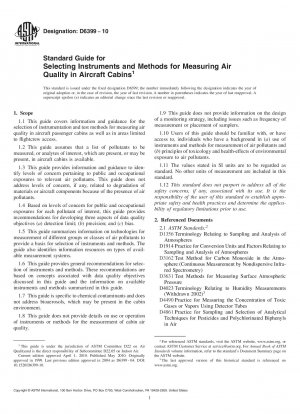ASTM D6399-10
Standard Guide for Selecting Instruments and Methods for Measuring Air Quality In Aircraft Cabins
- Standard No.
- ASTM D6399-10
- Release Date
- 2010
- Published By
- American Society for Testing and Materials (ASTM)
- Status
- Replace By
- ASTM D6399-18
- Latest
- ASTM D6399-18
- Scope
This guide may be used to identify instruments and methods for measuring air quality in aircraft cabins. Such measurements may be undertaken to:
Conduct monitoring surveys to characterize the aircraft cabin environment and to assess environmental conditions. Results of such measurements could then be compared with relevant standards or guidelines for assessment of health and comfort of passengers and flight attendants.
Investigate passenger and flight attendant complaints; or
Measure and compare the performance of new materials and systems for the aircraft cabin environment.
1.1 This guide covers information and guidance for the selection of instrumentation and test methods for measuring air quality in aircraft passenger cabins as well as in areas limited to flightcrew access.
1.2 This guide assumes that a list of pollutants to be measured, or analytes of interest, which are present, or may be present, in aircraft cabins is available.
1.3 This guide provides information and guidance to identify levels of concern pertaining to public and occupational exposures to relevant air pollutants. This guide does not address levels of concern, if any, related to degradation of materials or aircraft components because of the presence of air pollutants.
1.4 Based on levels of concern for public and occupational exposures for each pollutant of interest, this guide provides recommendations for developing three aspects of data quality objectives (a) detection limit; (b) precision; and (c) bias.
1.5 This guide summarizes information on technologies for measurement of different groups or classes of air pollutants to provide a basis for selection of instruments and methods. The guide also identifies information resources on types of available measurement systems.
1.6 This guide provides general recommendations for selection of instruments and methods. These recommendations are based on concepts associated with data quality objectives discussed in this guide and the information on available instruments and methods summarized in this guide.
1.7 This guide is specific to chemical contaminants and does not address bioaerosols, which may be present in the cabin environment.
1.8 This guide does not provide details on use or operation of instruments or methods for the measurement of cabin air quality.
1.9 This guide does not provide information on the design of a monitoring strategy, including issues such as frequency of measurement or placement of samplers.
1.10 Users of this guide should be familiar with, or have access to, individuals who have a background in (a) use of instruments and methods for measurement of air pollutants and (b) principles of toxicology and health-effects of environmental exposure to air pollutants.
1.11 The values stated in SI units are to be regarded as standard. No other units of measurement are included in this standard.
1.12 This standard does not purport to address all of the safety concerns, if any, associated with its use. It is the responsibility of the user of this standard to establish appropriate safety and health practices and determine the applicability of regulatory limitations prior to use.
ASTM D6399-10 Referenced Document
- ASTM D1356 Standard Terminology Relating to Sampling and Analysis of Atmospheres*, 2024-04-19 Update
- ASTM D1914 Standard Practice for Conversion Units and Factors Relating to Sampling and Analysis of Atmospheres
- ASTM D3162 Standard Test Method for Carbon Monoxide in the Atmosphere (Continuous Measurement by Nondispersive Infrared Spectrometry)
- ASTM D3631 Standard Test Methods for Measuring Surface Atmospheric Pressure
- ASTM D4023 Standard Terminology Relating to Humidity Measurements
- ASTM D4490 Standard Practice for Measuring the Concentration of Toxic Gases or Vapors Using Detector Tubes
- ASTM D4861 Standard Practice for Sampling and Selection of Analytical Techniques for Pesticides and Polychlorinated Biphenyls in Air
- ASTM D5149 Standard Test Method for Ozone in the Atmosphere: Continuous Measurement by Ethylene Chemiluminescence
- ASTM D5156 Standard Test Methods for Continuous Measurement of Ozone in Ambient, Workplace, and Indoor Atmospheres (Ultraviolet Absorption)
- ASTM D5197 Standard Test Method for Determination of Formaldehyde and Other Carbonyl Compounds in Air (Active Sampler Methodology)
- ASTM D5466 Standard Test Method for Determination of Volatile Organic Chemicals in Atmospheres (Canister Sampling Methodology)
- ASTM D6196 Standard Practice for Selection of Sorbents and Pumped Sampling/Thermal Desorption Analysis Procedures for Volatile Organic Compunds in Air
- ASTM D6245 Standard Guide for Using Indoor Carbon Dioxide Concentrations to Evaluate Indoor Air Quality and Ventilation
ASTM D6399-10 history
- 2018 ASTM D6399-18 Standard Guide for Selecting Instruments and Methods for Measuring Air Quality in Aircraft Cabins
- 2010 ASTM D6399-10 Standard Guide for Selecting Instruments and Methods for Measuring Air Quality In Aircraft Cabins
- 2004 ASTM D6399-04 Standard Guide for Selecting Instruments and Methods for Measuring Air Quality In Aircraft Cabins
- 1999 ASTM D6399-99a Standard Guide for Selecting Instruments and Methods for Measuring Air Quality In Aircraft Cabins
